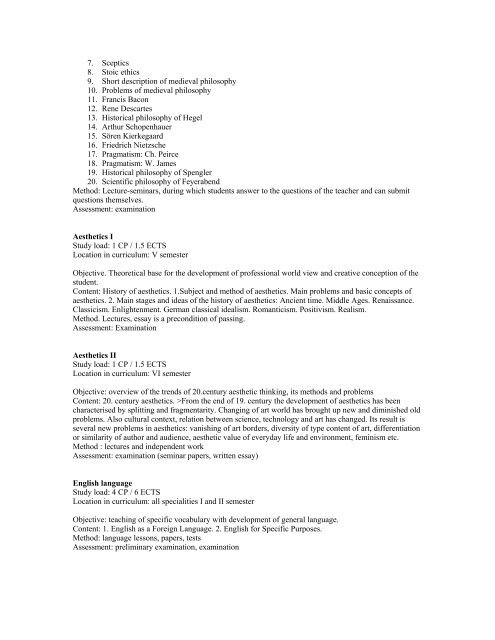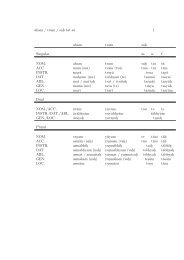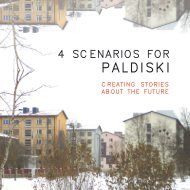Fine Art - Eesti Kunstiakadeemia / Estonian Academy of Arts
Fine Art - Eesti Kunstiakadeemia / Estonian Academy of Arts
Fine Art - Eesti Kunstiakadeemia / Estonian Academy of Arts
You also want an ePaper? Increase the reach of your titles
YUMPU automatically turns print PDFs into web optimized ePapers that Google loves.
7. Sceptics<br />
8. Stoic ethics<br />
9. Short description <strong>of</strong> medieval philosophy<br />
10. Problems <strong>of</strong> medieval philosophy<br />
11. Francis Bacon<br />
12. Rene Descartes<br />
13. Historical philosophy <strong>of</strong> Hegel<br />
14. <strong>Art</strong>hur Schopenhauer<br />
15. Sören Kierkegaard<br />
16. Friedrich Nietzsche<br />
17. Pragmatism: Ch. Peirce<br />
18. Pragmatism: W. James<br />
19. Historical philosophy <strong>of</strong> Spengler<br />
20. Scientific philosophy <strong>of</strong> Feyerabend<br />
Method: Lecture-seminars, during which students answer to the questions <strong>of</strong> the teacher and can submit<br />
questions themselves.<br />
Assessment: examination<br />
Aesthetics I<br />
Study load: 1 CP / 1.5 ECTS<br />
Location in curriculum: V semester<br />
Objective. Theoretical base for the development <strong>of</strong> pr<strong>of</strong>essional world view and creative conception <strong>of</strong> the<br />
student.<br />
Content: History <strong>of</strong> aesthetics. 1.Subject and method <strong>of</strong> aesthetics. Main problems and basic concepts <strong>of</strong><br />
aesthetics. 2. Main stages and ideas <strong>of</strong> the history <strong>of</strong> aesthetics: Ancient time. Middle Ages. Renaissance.<br />
Classicism. Enlightenment. German classical idealism. Romanticism. Positivism. Realism.<br />
Method. Lectures, essay is a precondition <strong>of</strong> passing.<br />
Assessment: Examination<br />
Aesthetics II<br />
Study load: 1 CP / 1.5 ECTS<br />
Location in curriculum: VI semester<br />
Objective: overview <strong>of</strong> the trends <strong>of</strong> 20.century aesthetic thinking, its methods and problems<br />
Content: 20. century aesthetics. >From the end <strong>of</strong> 19. century the development <strong>of</strong> aesthetics has been<br />
characterised by splitting and fragmentarity. Changing <strong>of</strong> art world has brought up new and diminished old<br />
problems. Also cultural context, relation between science, technology and art has changed. Its result is<br />
several new problems in aesthetics: vanishing <strong>of</strong> art borders, diversity <strong>of</strong> type content <strong>of</strong> art, differentiation<br />
or similarity <strong>of</strong> author and audience, aesthetic value <strong>of</strong> everyday life and environment, feminism etc.<br />
Method : lectures and independent work<br />
Assessment: examination (seminar papers, written essay)<br />
English language<br />
Study load: 4 CP / 6 ECTS<br />
Location in curriculum: all specialities I and II semester<br />
Objective: teaching <strong>of</strong> specific vocabulary with development <strong>of</strong> general language.<br />
Content: 1. English as a Foreign Language. 2. English for Specific Purposes.<br />
Method: language lessons, papers, tests<br />
Assessment: preliminary examination, examination






